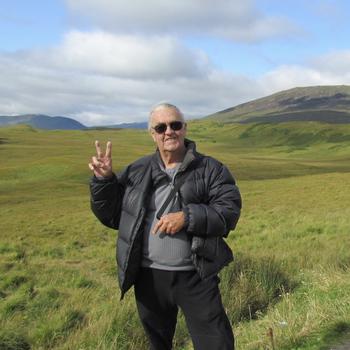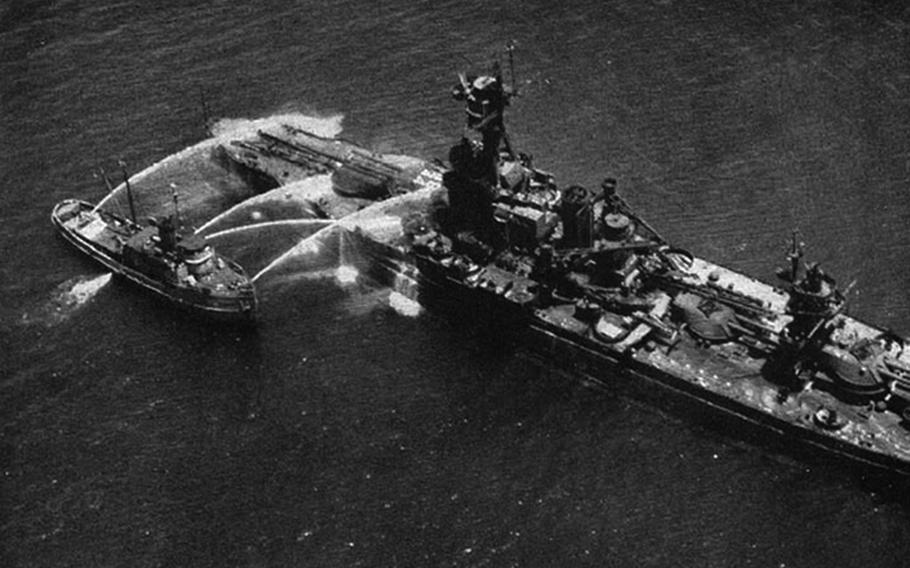(Illustration by Noga Ami-rav/Stars and Stripes)
WASHINGTON — Michael Cobb, a former Navy seaman, witnessed the detonation of more than 20 atomic bombs over Christmas Island in the Indian Ocean in 1962 and 1963.
He and other active-duty service members were handed only plastic goggles to shield their eyes and then told to turn their backs when they saw the bright light from the explosion, his widow Karen Bosch Cobb said.
Cobb, whose four-year military service ended in 1963, experienced “terrible pain” in his bones following the nuclear bomb tests, she said.
He later was diagnosed with bladder cancer that spread to his lungs, and he died in 2023. The cancers were presumed to be connected to his radiation exposure during military service, his wife said.
In 2021, he received a one-time compensation from the Radiation Compensation Exposure Fund established by Congress after filing the required paperwork.

Michael Cobb, a Navy veteran, witnessed the detonation of more than 20 atomic bombs over Christmas Island in the Indian Ocean from 1962-1963 during active-duty service, said Karen Bosch Cobb, his widow. He died from cancer in 2023 connected to his radiation exposure from military service. Cobb is shown in this 2013 family photo, 10 years prior to his death. (Karen Bosch Cobb)
“My husband saw the payment as recognition for what he went through,” Karen Bosch Cobb said.
The Radiation Exposure Compensation Act offers an apology and monetary compensation to individuals who contracted certain cancers and other serious diseases from exposure to radiation from above-ground nuclear weapons tests, according to the Department of Justice.
But time is running out for veterans to file for compensation under the fund established to assist them with the long-term health effects of radiation exposure after participating in atomic bomb tests more than 50 years ago.
Veterans have until June 10 to submit claims for a one-time payment of $75,000, the Justice Department said. The compensation fund also awards payments to workers who mined, processed and transported uranium for manufacturing bombs, and civilians who lived downwind from specific test sites.
Legislation authorizing the payments is scheduled to sunset after 34 years, at which time the fund will be closed permanently. Veterans are advised to submit claims by June 7. They must be postmarked by June 10 to be accepted.
“Often illnesses associated with ionizing radiation take decades to appear,” said Air Force veteran Keith Kiefer, who is the national commander at the National Association of Atomic Veterans, a nonprofit organization.
Kiefer, who was exposed to radiation during the cleanup of a nuclear bomb site at Eniwetok Atoll in the South Pacific, described the path to financial help from the Department of Veterans Affairs as difficult, making the compensation fund more critical for veterans.
“The Radiation Exposure Compensation Fund is much less bureaucratic than going through the VA for compensation,” he said.
More than $2.7 billion has been paid to 41,000 individuals filing claims, according to the Justice Department.
In 2022, Congress granted atomic veterans and others exposed to radiation from military explosives a two-year extension of the Radiation Exposure Compensation Act to submit their claims.
Sens. Mitt Romney and Mike Lee, both Utah Republicans, have submitted legislation to continue the compensation fund for another two years.
Members of 11th Airborne Division watch the mushroom cloud of an atomic bomb test at Frenchman’s Flat in Nevada in November 1951. (Library of Congress)
Separate legislation called the Radiation Exposure Compensation Reauthorization Act would extend the fund for five more years and add locations within the U.S. where radioactive waste exposures occurred. The Congressional Budget Office estimated total compensation under the bill would be about $50 billion.
Sponsored by Sen. Josh Hawley, R-Mo., the bill was forwarded to the House after passage in the Senate in March. A hearing on the bill has not been scheduled.
Karen Bosch Cobb said her husband remained stoic about his experience bearing witness to the atomic bomb blasts, though it was important that he received burial benefits and a headstone from the VA recognizing his military service.
But the legislation excludes thousands of former service members who removed contamination from the sites decades after the bombings. Costs are a concern to lawmakers.
“Compensation may very well be warranted for individuals harmed by the government’s nuclear activities, but the substantial deficit impact of the legislation is concerning and unnecessary,” the Committee for a Responsible Federal Budget, a Washington think tank, wrote in March.
Kiefer, 67, participated in nuclear debris cleanup in 1978 at Eniwetok Atoll, a string of islands in the Pacific Ocean where the military dropped more than 40 nuclear bombs in tests after World War II.
“Some of the bombings at Eniwetok Atoll vaporized the islands, so they no longer exist,” said Kiefer, whose military service was from 1975-1981.
Kiefer, a former airman first class, said he was among 6,000 members deployed to Eniwetok from 1977-1980 for the radioactive waste cleanup. He believes he was exposed to radioactive waste as he dug up and repaired damaged underground communications cables.
Kiefer learned he was sterile after returning home from Eniwetok, when he and his wife tried to start a family. He also was diagnosed with a thyroid condition after his military service. His health problems continued, and he was diagnosed with degenerative bone disease and a blood-clotting disorder that caused embolisms in his lungs.
The National Association of Atomic Veterans is advocating for the radiation exposure compensation fund to continue, though it does not cover veterans who cleaned up the contamination from sites where nuclear weapons were used.
“It is important to preserve the fund and represent our members. There are veterans who were witnesses to the atomic bombs tests that would qualify with the extension. We will ask for the Eniwetok Atoll veterans to be added later,” Kiefer said.
Former service members who cleared debris from Eniwetok Atoll “encountered low levels of radiological contamination and have a low risk of health problems,” according to the VA.
The VA might deny some claims because the “U.S. government has asserted that the veterans were not exposed to unsafe levels of radiation,” according to Atomic Heritage Foundation, a nonprofit organization.
Veterans, however, are eligible for compensation for health problems connected to radiation exposure under the Sergeant First Class Heath Robinson Honoring our Promise to Address Comprehensive Toxics Act, or PACT Act, the VA said.
The legislation, adopted in 2022, provides coverage to veterans who developed medical conditions after toxic exposures during military service, including from burn pits, Agent Orange and radiation.
But the VA did not approve most claims submitted for radiation exposure from August 2022 to August 2023, according to the agency. While the VA does cover radiation exposure, approval is for specific diseases including certain types of cancer.
Last year, the PACT Act extended eligibility to veterans who took part in cleanups at Eniwetok Atoll and crash sites from the 1960s of Air Force B-52 bombers in Greenland and Spain.
Kiefer said he filed disability claims in 2023 with the VA that are pending. Prior to the PACT Act, Kiefer said he submitted service-connected disability claims to the VA that were denied.
“In my view, the VA has had a propensity to deny claims from ionizing radiation exposures. They don’t understand it,” he said.

Navy veteran John Wills competed in the Valor Games, a paralympic sport competition, in 2013. Wills suffered degenerative bone loss after assisting in the cleanup of nuclear contamination at Enewetak Atoll in the South Pacific, a nuclear bomb test site. The Department of Veterans Affairs has denied his disability claims for radiation exposure. (John Wills)
John Wills, a 66-year-old Navy veteran who lives in North Carolina, also participated in the Eniwetok Atoll cleanup in 1978 and 1979.
Wills, who was a petty officer second class, was medically discharged in 1982 for health problems that he developed after the radiation cleanup at Eniwetok. He was diagnosed with a degenerative bone condition that led to severe bone loss and deterioration in his shoulders, hips and legs. He now uses a wheelchair.
“After I left the service, the bone loss caused my left leg to shorten, which became progressively worse over the years. My hips also started to pop and crack. I am now sitting with my left leg four inches shorter than my right,” Willis said.
He also was diagnosed with an enlarged heart in 2005. But Wills said his claim with the VA for disability compensation related to his medical conditions was denied in 2015.
The VA reviews claims for radiation exposure utilizing an assessment of the size and nature of the radiation dose, according to the agency.
Wills said he refiled his claim the same day that the PACT Act was signed into law in August 2022. But it too was denied six months later, he said.
“The VA does not understand radiation victims and what they go through,” he said.
But Wills received an unexpected call from the VA that his denied claims would get a second look.
“I got a call from a VA representative in February who said my case was undergoing a higher review, and I would get a call back within a couple weeks,” he said.
Wills is still waiting for the call four months later. He has received no other correspondence, he said.
“I get up each day and make sure that the phone line is clear. All I can do is wait,” Wills said. “Hopefully the VA realizes they should do the right thing for me — and for the other atomic veterans.”

The USS New York battleship was heavily contaminated during the Baker shot for the atomic bomb test for Operation Crossroads at the Bikini Atoll in the Pacific in 1946. (Department of Defense)